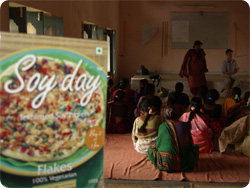
BRINQ is the home of entrepreneur and product designer Patrick Donohue, whose work focuses on high impact startups and products.

Where was the market for Solae's protein in rural India? It needed to be created.
On Monday, the Wall Street Journal published an article by my colleague Erik Simanis about our work developing new markets in the base of the world's income pyramid. Erik is a pioneer in business development methodologies for the BoP.
The Base of the Pyramid is not actually a market. True, those billions of low-income people have a lot in common. But they don't have two of the vital characteristics you need to have a consumer market. They haven't been conditioned to think that the products being offered are something one would even buy. And they haven't adapted their behaviors and budgets to fit the products into their lives. A consumer market is nothing less than a lifestyle built around a product.
Erik uses a range of examples including bottled water in the U.S., P&G's PUR water cleaning powder, KickStart's MoneyMaker pump, and our own work with Solae in India to demonstrate that companies should think twice before assuming a market for their products exists, even if those products are well designed. And if a market doesn't exist then traditional market entry approaches - the kind that most companies use and most managers are taught - are largely ineffective. Instead, companies need to learn to create markets.
Since the first BoP Protocol pilot in 2005, our work has focused more and more on the challenges of creating new markets and building the enterprises that enable them. Over the years, we have learned a number of hard, but handy, lessons. Three of those lessons are described below.
As Erik points out, markets are not so much about meeting needs, but building lifestyles. This is a particularly important lesson for organizations pursuing enterprise approaches to "basic needs" problems. In India, we helped develop several variations of the same business for Solae. The one that focused on nutrition struggled, while the one that focused on lifestyle thrived... even while providing the same nutritional benefit.
Those solutions may seem like poor options to many of us, but asking people to change their lives is rarely simple. The Solae businesses overcame this by working with initial groups of friends & neighbors to co-create the value the business offered. Those early consumers felt a strong sense of ownership over the change Solae was asking them to make (integrating soy protein into their diets) and they became both a living demonstration for the business and a pathway to new consumers via their own friends & families.
Creating consumers means never passing on an opportunity for your business to engage with the people you want to serve, especially in the development and definition of the business itself. So a consumer development plan and a business development plan go hand in hand, just be ready for them to take you in directions you might not have imagined before.